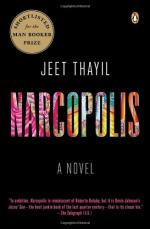|
This section contains 646 words (approx. 2 pages at 400 words per page) |

|
Narcopolis Summary & Study Guide Description
Narcopolis Summary & Study Guide includes comprehensive information and analysis to help you understand the book. This study guide contains the following sections:
This detailed literature summary also contains Quotes and a Free Quiz on Narcopolis by Jeet Thayil.
NOTE: The following version of this book was used to create this study guide: Thayil, Jeet. Narcopolis. Penguin Paperbacks, 2012.
Narcopolis is a novel of drugs and crime that follows a cast of characters over the course of 30-some years in their Bombay slum. The novel itself is told in both first and third-person, in a kind of stream-of-consciousness that is often suddenly interrupted by new events and new narrators. Beginning in the 1970s, the characters themselves all tend to revolve around Rashid’s, a combination opium den and brothel. Rashid himself is both an addict and a family man, brutal with his son, Jamal, and adheres to his Muslim faith only when convenient. Rashid spends his days counting his money and getting high.
One of the most popular workers at Rashid’s is a transgendered girl named Dimple. As a young boy, Dimple was forcibly surgically altered following the death of his mother. Now with very limited options, Dimple becomes an opium pipe tender for customers, where she becomes addicted to opium over time. Dimple also serves as a prostitute, looking for a better way of life but never finding the right chance or the right option.
Two of Dimple’s customers provide a contrast with how she is treated. Dom comes to see her to smoke opium, for her company, and to read books to her, for he recognizes that Dimple loves to read. Rumi, on the other hand, is a customer who has a decent job with his wife’s company, but relishes in what he considers adventures in the slums – such as having violent sex with Dimple.
Dimple comes to reflect on how she came to work at Rashid’s by way of Mr. Lee, a Chinese refugee who began his own opium den and who sheltered Dimple until his death. It was using Lee’s ancient opium pipes as leverage that Dimple secured her job at Rashid’s.
The years pass in a haze for the characters. The 1980s come on, and Rashid is approached by Khalid about transforming his opium den and brothel into a place for cocaine. Rashid refuses, and his place is shut down by corrupt government officials and corrupt police. Rashid then has Khalid’s son kidnapped, and returned safely once his den is reopened. As cocaine comes onto the scene in force, opium supplies, like Salim, begin lacing the opium with strychnine to give it a more potent kick and to beat out opium.
As the 1980s wear on, and the 1990s come on, drugs of every imaginable kind become available. But the hard-partying lifestyle of those in the slums finally begin to catch up to them. Dom decides he will leave Bombay to begin a new life. Dimple realizes she will die if she stays in the city, so she begs Dom to take her with him. Instead, Dom checks Dimple into a rehab place called Safer. Safer is also attended by Rumi who has since divorced his wife and lost everything. Rehab does not stick with Rumi, however. Rashid’s son takes over the business, transforming the den into a serious call center and hub of operations for drug sales. Rashid, fat and old, regrets only not having gone with cocaine at the den when he had the chance. In 2004, Rashid receives a visit from Dom, who asks how everyone is doing. Rashid explains everyone is now dead except for them.
Dom asks to bring home some old things from the den as souvenirs, including an opium pipe. He intends to turn them into a museum exhibit, or so he tells Rashid. Rashid says the exhibit should display their shame for the way their lives have been lived. At his apartment, Dom smokes the opium pipe, and it is revealed the entire book has been only one of his opium dreams.
Read more from the Study Guide
|
This section contains 646 words (approx. 2 pages at 400 words per page) |

|



